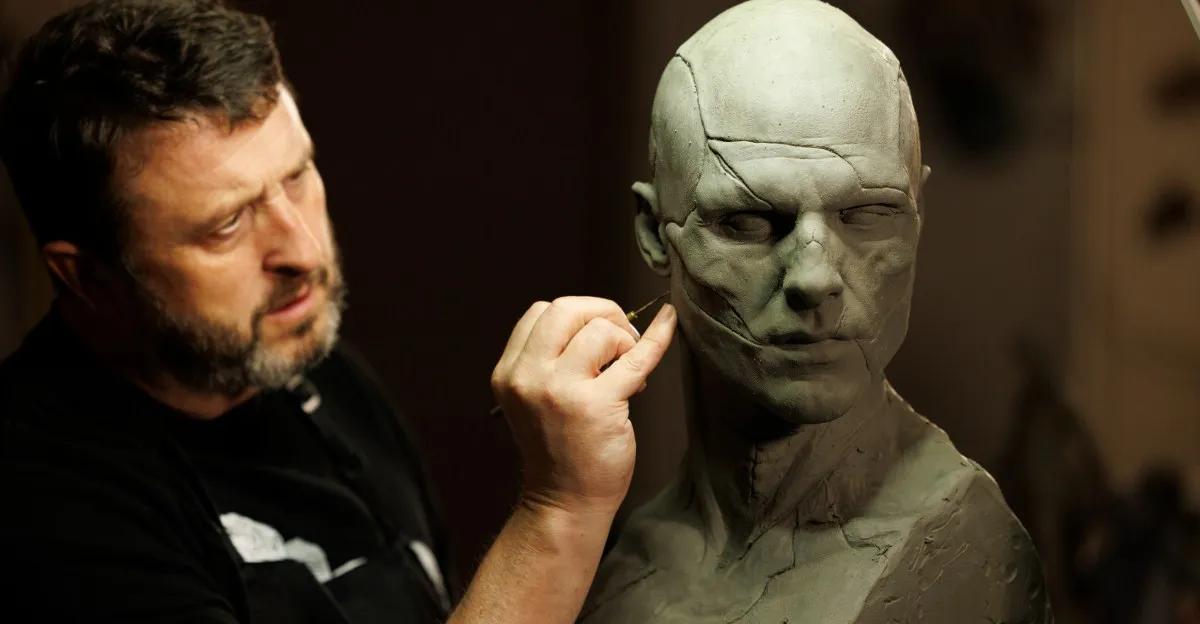
For renowned sculptor and special effects artist Mike Hill, the partnership with acclaimed director Guillermo del Toro began with a shared fascination for the classic tale of Frankenstein. Their story dates back several years, when Hill was showcasing his impressive sculptures at a convention in Burbank. During the event, del Toro encountered some of Hill's monstrous creations, which left a lasting impression on him. Driven by admiration, del Toro embarked on a quest to find Hill, managing to track down his contact information through an obscure model kit forum. Reflecting on this unique experience, Hill humorously describes del Toro's investigative efforts as "very Columbo-esque." He recalls, "I don’t know how he found me from some 20-year-old website," illustrating the lengths del Toro would go to connect with creative talent.
The initial contact led to Hill's first commission from del Toro: a sculpture depicting the legendary actor Boris Karloff during the makeup application for the iconic 1931 film Frankenstein. This piece later found its home in del Toro's renowned Bleak House. Hill reflects on this moment, stating, “Immediately it was Frankenstein,” marking the beginning of their fruitful collaboration. Following this, Hill contributed to creature designs for several of del Toro's cinematic masterpieces, including Nightmare Alley, The Shape of Water, and the Netflix anthology series Cabinet of Curiosities.
However, when whispers circulated that del Toro was embarking on a long-awaited adaptation of Frankenstein, Hill experienced a wave of anxiety as his phone remained silent. “I was fretting because I knew he was going to do Frankenstein and hadn’t been in touch with me,” Hill admits, revealing the stress of an artist longing to be part of a project close to his heart. Fortunately, del Toro had not overlooked his collaborator. He invited Hill for breakfast, stating, “Listen, we’re doing Frankenstein. If you’re not doing it, then I’m not doing it, so it depends on you right now.” Naturally, Hill accepted, eager to contribute to this reinterpretation of a classic story.
The upcoming Frankenstein adaptation, which had a brief theatrical release and is set to stream on Netflix on November 7th, posed significant challenges for Hill. Given the cultural significance of Karloff's portrayal from the original 1931 film, Hill faced the daunting task of designing a creature that would stand out among countless variations. “It was very difficult trying to come up with something that no one had ever seen,” he acknowledges. The design process was a collaborative effort, with del Toro providing direction through what he didn’t want rather than explicit design instructions. For instance, del Toro emphasized that the creature should not be hideous, ruling out heavy, unattractive stitching.
Hill immersed himself in research, studying 18th-century surgical techniques to inform his design choices. “I just wanted to make him of the period, like he was built in the 1800s,” Hill explains. The result is a tall, lean creature adorned with scars that create an almost geometric pattern across his body. This design aligns with the film's narrative, which delves into the pseudoscientific process Victor Frankenstein employs to create life. Hill articulates the essence of the character, stating, “There’s a certain beauty that Victor was striving for... he tried to make a beautiful glass window; it just ended up stained and broken.”
In the early stages of the project, Hill navigated the uncertainty of working without a script or a finalized cast. After dedicating eight months to designing prosthetics, the actor initially slated to portray the creature departed due to a conflict. Del Toro then provided Hill with a list of potential replacements, with one actor standing out: Jacob Elordi. Hill was drawn to Elordi’s “demeanor, his gangliness, his limbs, his doe-like eyes,” believing he was the perfect fit for the role. Standing at an impressive 6-foot-5, Elordi possesses the striking features that make the job of a makeup artist significantly easier. Hill notes, “Jacob’s bone structure made things a lot easier... speaking as a prosthetics artist, chins are a pain in the ass.”
The final design of the creature comprises 42 different prosthetic pieces, requiring Elordi to spend around 10 hours in the makeup chair for the full-body application. A crucial aspect of this design is its ability to evolve throughout the film. Initially, the creature appears bald and nearly naked, symbolizing a childlike innocence. However, after being rejected by his creator, his appearance shifts to a more hardened look, complete with long hair and a cloak. As the character transforms, Elordi's demeanor shifts from timid to menacing, underscoring the dramatic evolution of the creature.
Ultimately, the Frankenstein project proved to be a fitting collaboration between Hill and del Toro. Reflecting on his lifelong passion for creating monsters, Hill shares that Mary Shelley’s story has always been a significant influence in his artistic journey. He has crafted multiple interpretations of the creature as a professional artist and is currently developing a short film inspired by a decade-old sculpture. Tapping into his dreams of reimagining Frankenstein, Hill expresses his satisfaction, stating, “I always dreamed that he would make it.”